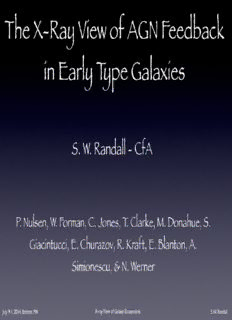
The X-Ray View of AGN Feedback in Early Type Galaxies PDF
Preview The X-Ray View of AGN Feedback in Early Type Galaxies
The X-Ray View of AGN Feedback in Early Type Galaxies S. W. Randall - CfA P. Nulsen, W. Forman, C. Jones, T. Clarke, M. Donahue, S. Giacintucci, E. Churazov, R. Kraft, E. Blanton, A. Simionescu, & N. Werner July 9-1, 2014, Boston, MA X-ray View of Galaxy Ecosystems S. W. Randall X-ray Emission from Early Type Galaxies • X-rays from BCG’s from early rocket experiments (e.g., Bryam+66) • First detected in “normal” elliptical galaxies with Einstein satellite (e.g., Forman+79) • Emission a combination of that from diffuse thermal and point sources, with a wide range of relative contributions • Focus here is on diffuse emission and AGN feedback July 9-1, 2014, Boston, MA X-ray View of Galaxy Ecosystems S. W. Randall What is Feedback and Why Do We Care? • Output from compact objects (stars, black holes) affects their formation and/or growth rates • Affects the structure (self-similarity) and evolution of clusters and groups • Buoyant bubbles redistribute gas and metals • Implications for cosmology (clusters as cosmological probes, growth of structure) • Regulates black hole growth rate • Regulates star formation rate => galaxy evolution theory • ICM microphysics (viscosity, turbulence, transport...) • Solution to the “cooling flow problem” July 9-1, 2014, Boston, MA X-ray View of Galaxy Ecosystems S. W. Randall AGN Feedback Modes Radiative (Quasar) Mode Kinetic (Radio) Mode Kinetic power is negligible Radiative power is negligible Black hole accreting close to Black hole accreting at a few to ten Eddington limit percent of Eddington limit Radiation couples BH energy BH energy output couples to gas output to the gas through jets, via bubbles and shocks Dominant at higher z (2-3) Dominant in the local Universe Reviews: Peterson & Fabian 06; McNamara & Nulsen 07; Cattaneo+09; Fabian 12; Gitti+12 Transition from radiative to kinetic mode, see Churazov+05 Also stellar feedback, important when ≲ 200 km/s 𝞼 v July 9-1, 2014, Boston, MA X-ray View of Galaxy Ecosystems S. W. Randall AGN Feedback Modes Radiative (Quasar) Mode Kinetic (Radio) Mode Kinetic power is negligible Radiative power is negligible Black hole accreting close to Black hole accreting at a few to ten Eddington limit percent of Eddington limit Radiation couples BH energy BH energy output couples to gas output to the gas through jets, via bubbles and shocks Dominant at higher z (2-3) Dominant in the local Universe Reviews: Peterson & Fabian 06; McNamara & Nulsen 07; Cattaneo+09; Fabian 12; Gitti+12 Transition from radiative to kinetic mode, see Churazov+05 Also stellar feedback, important when ≲ 200 km/s 𝞼 v July 9-1, 2014, Boston, MA X-ray View of Galaxy Ecosystems S. W. Randall Evidence for Feedback Peterson+01 • Early XMM-Newton and Chandra observations showed that there is not as much gas cooling to low temperatures as predicted in “cool core” clusters (the “cooling flow problem”) • Implies balance of heating and cooling rates (McNamara & Nulsen 2007) July 9-1, 2014, Boston, MA X-ray View of Galaxy Ecosystems S. W. Randall Perseus cluster Cavities, shocks, and sound waves observed in clusters, groups, and individual galaxies M84 Credit: CXC/NASA Finoguenov+08 Fabian 12 July 9-1, 2014, Boston, MA X-ray View of Galaxy Ecosystems S. W. Randall Correlation with cavity power and cooling luminosity over six orders of magnitude, and out to Z∼0.7 (Birzan+04; Rafferty +06; Nulsen+07; Hlavacek-Larrondo+12) Fabian 12 July 9-1, 2014, Boston, MA X-ray View of Galaxy Ecosystems S. W. Randall Evidence for Feedback • Central cooling times < t without prodigious star Hubble formation (implies balance of heating and cooling rates) • Cavities, shocks, and sound waves in X-ray observations of clusters, groups, and galaxies • Correlation between cavity power and cooling luminosity • Central entropy floor (∼10 keV cm2) in cluster BCG’s • High-velocity galactic outflows (e.g., Rupke & Veilleux 11) • M - relation? Cosmic Downsizing? 𝞼 BH v July 9-1, 2014, Boston, MA X-ray View of Galaxy Ecosystems S. W. Randall The (Kinetic) AGN Feedback Cycle Jets inflate Flows onto Drives AGN cavities, Gas cools AGN outburst driving shocks Slows mass Cavities and Cavities rise flow, and Slows cooling shocks heat buoyantly heating ICM Mechanical energy available to heat the ICM and balance radiative cooling is in cavities and shocks July 9-1, 2014, Boston, MA X-ray View of Galaxy Ecosystems S. W. Randall
Description: